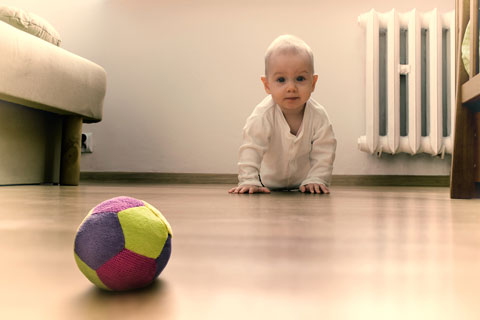About this Video
This Early Learning Moment provides an overview of the Curiosity & Initiative section of the Illinois Early Learning Guidelines for Children Birth to Age 3. This section describes how infants and toddlers use all their senses to learn about their world. As children develop new skills, they build understanding about the world around them. Their curiosity leads to exploration and the development of motor, cognitive, and language skills. Children show initiative by making choices throughout their day.
Video
Explanation of the Curiosity and Initiative
As children grow, they learn about their world. Children are born with a natural interest in their environment, including the people and objects all around them. This instinctive drive to learn about their world is known as curiosity.
For example, as children gain more physical control over their bodies, they learn they can move toward objects by rolling or crawling. As they mature, children might experiment with different ways to use materials and objects.
The Illinois Early Learning Guidelines for Children Birth to Age 3 present the following indicators for children in the area of curiosity and initiative, which is part of the Approaches to Learning section of the Illinois Early Learning Guidelines. These indicators describe skills, behaviors, and knowledge that children exhibit in curiosity and initiative during the age ranges listed.
Indicators for children
Birth to 9 months
- Observes the environment and people; tracks a toy as it moves from one point to another
- Shows interest in him- or herself, e.g., gazes at hands, places feet in mouth
- Actively explores new objects found in the environment, e.g., touches, pats, and mouths
- Attempts to initiate interaction with others, e.g., smiles, reaches for a caregiver
- Participates in joint attention with caregiver(s), e.g., focuses on the same object
7 to 18 months
- Demonstrates an interest in new objects by manipulating and turning the object
- Uses familiar objects in new ways, e.g., places a toy basket on head
- Moves toward a new activity by crawling or walking
- Begins to demonstrate preferences for objects and/or materials, e.g., selects a book to read when given options
- Engages familiar adults in meaningful interactions, e.g., points to favorite toy, brings a book over to be read
16 to 24 months
- Demonstrates an interest in new activities and a willingness to try out new experiences
- Engages in active exploration in new environments, e.g., walks over to a toy shelf in an unfamiliar home or classroom
- Initiates play with others, e.g., a grandparent, sibling, or teacher
- Experiments with different ways to use materials and objects
21 to 36 months
- Observes other children in play
- Enjoys accomplishing simple goals, e.g., completing a puzzle, blowing a bubble
- Asks questions while interacting with others, e.g., “why,” “what,” “how”
- Participates in a broader array of experiences, e.g., outdoor jungle gyms, art projects
Setting Up for Success
There are many ways caregivers can set up the environment so a child can be successful. Caregivers can also interact with children in ways that will support their development.
Caregivers can set the stage for interaction by:
- Sitting close to the child so interactions are possible
- Providing objects that are appropriate to the child’s age and development
- Physically supporting the child to allow interaction
Caregivers can maintain the child’s interest and attention by:
- Showing interest in the child
- Encouraging the child
- Responding to and being sensitive to the child’s emotions
- Introducing new activities when needed
Caregivers can take turns by:
- Responding to the child’s initiations
- Establishing routines
- Letting the child know that a response is expected and waiting for a response
- Imitating the child and waiting for a response
Caregivers can match and follow by:
- Observing the child and joining in the activity/interaction
- Following the child’s lead
- Commenting on the child’s activities
Caregivers can support learning by:
- Elaborating on communication attempts
- Adding new actions or elements to known routines
- Balancing support with expectations
- Presenting “dilemmas” for the child to solve
Self-Assessment and Reflection
We have watched Yana, Mario, and Aaron play. We have considered the ways their caregivers encouraged curiosity about the world around them and then supported their initiative to explore independently. Now, consider your own interactions with children.
Does your space have:
- Materials children can choose and reach independently?
- Enough materials for children to share?
- Pictures to help children find things and put them away?
- Cozy spaces for quiet play and access to spaces that allow energetic movement, such as the outdoors or a gym?
- Spaces for children to be together and places to be alone?
Are you ready to:
- Observe and consider the reasons behind children’s behavior?
- Watch and wait, but provide help and encouragement if needed?
- Take turns in play and conversation with children?
- Follow children’s ideas in play?”


